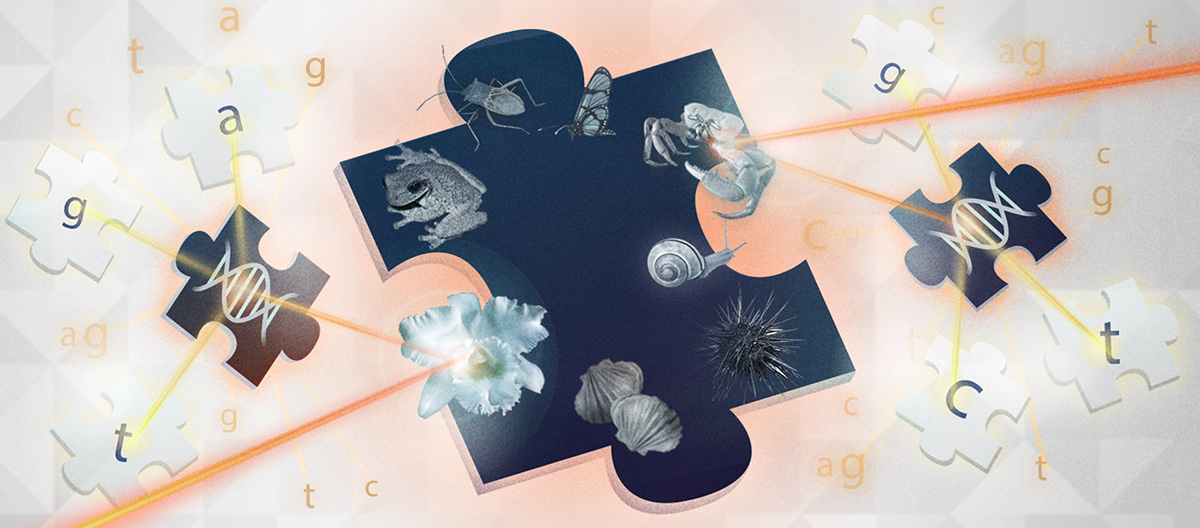 Biodiversity conservation is the reason and purpose of all environmental monitoring programs. It would then make sense for the measurement of biodiversity to be the main parameter for evaluating these programs. But the standard methodologies of morphological taxonomy, which are manual, individual and time-consuming, do not allow this. According to the Global Taxonomy Initiative, there are now between 5,000 and 7,000 professional taxonomists worldwide, each capable of identifying up to 1,000 species that have already been described. They are insufficient to identify all of the planet’s biodiversity, estimated at between 15 and 100 million species.
Biodiversity conservation is the reason and purpose of all environmental monitoring programs. It would then make sense for the measurement of biodiversity to be the main parameter for evaluating these programs. But the standard methodologies of morphological taxonomy, which are manual, individual and time-consuming, do not allow this. According to the Global Taxonomy Initiative, there are now between 5,000 and 7,000 professional taxonomists worldwide, each capable of identifying up to 1,000 species that have already been described. They are insufficient to identify all of the planet’s biodiversity, estimated at between 15 and 100 million species.
In the case of Brazil, our level of knowledge of aquatic biodiversity is still very low. Even the most cautious estimates indicate that there are seven times more species to be described than the 200,000 or so already recorded and with the current rate of description of 1,500 species per year, it would take at least eight centuries to complete the inventory of biodiversity (Lewinsohn & Prado, 2005). And that’s if all taxonomists dedicated themselves exclusively to describing new species.
For some groups of fauna, species identification requires special expertise and, for fragile organisms, special fixation techniques. Taxonomists become a bottleneck in a process that is slow and expensive. Even so, identification error rates are very high: around 25% for the same taxonomist and over 65% between taxonomists (Culverhouse et al., 2003).
Figure 3 – Biodiversity knowledge for the main invertebrate groups (source: International Union for Conservation of Nature – IUCN)
The lack of knowledge about Brazilian biodiversity has led to a conservative stance on the part of the environmental control agency, which is reflected in demands that can go beyond the scope of licensing and monitoring programs and into the realm of scientific research. Also contributing to this is the legal responsibility of the inspector for the act of inspection and the role of the public prosecutor’s office in overseeing the actions of the environmental agency. The result is a lack of clear criteria and standards in environmental licensing and monitoring processes, which increases the risk of obtaining operating licenses.
The conclusion is that traditional species identification methods, although irreplaceable for characterizing new organisms, are laborious and would be difficult to achieve the scale required for mass identification of organisms, which is necessary for the conservation of hydroelectric reservoirs. Especially if we consider the short deadlines the industry works with. The consequence is that many species will probably become extinct before we know it.
We therefore need a paradigm shift in the characterization of species in our biodiversity.
- DNA technologies make it possible to create a low-cost, highly efficient and practically real-time aquatic biodiversity monitoring program.
- The method uses as a source of biological material the extracellular DNA of organisms, present in residual form in the environment, also known as environmental DNA (eDNA).
- The method uses the Cytochrome Oxidase subunit I – COI gene, also known as the barcode of life for its ability to differentiate metazoan organisms down to species level. Other genes, such as the 16S unit of ribosomal RNA, can be used to identify microorganisms.
- The method uses tiny sample volumes: between 10 and 1 g of sediment or suspended particulate matter.
- With this technique, we can produce biodiversity profiles and phylogenetic studies based on known species or ‘operational taxonomic units’, organisms whose species have not yet been identified.
- The DNA is sequenced in an automated way, processing hundreds of samples a day.
- Identification is also automated and computerized, in which bioinformatics algorithms compare the genetic code of the specimens in the sample with those in private and public databases.
- The system operates in a computational cloud, enabling automatic scaling of processing capacity and data storage.

